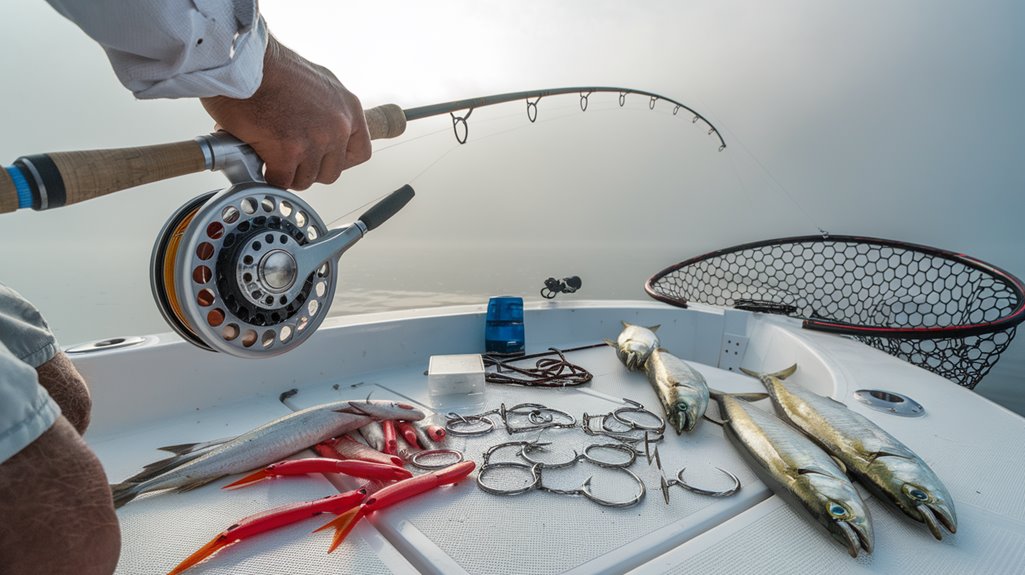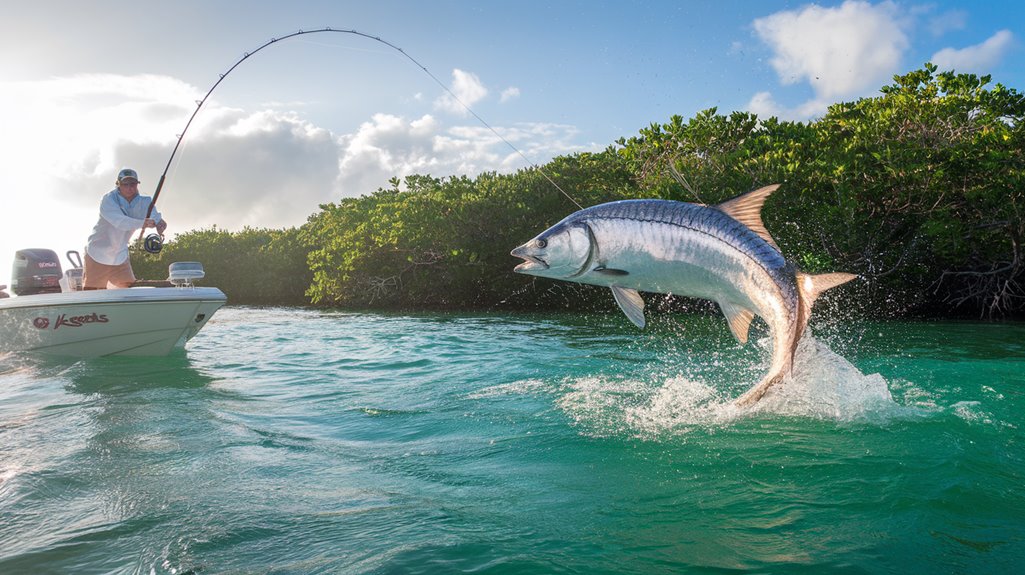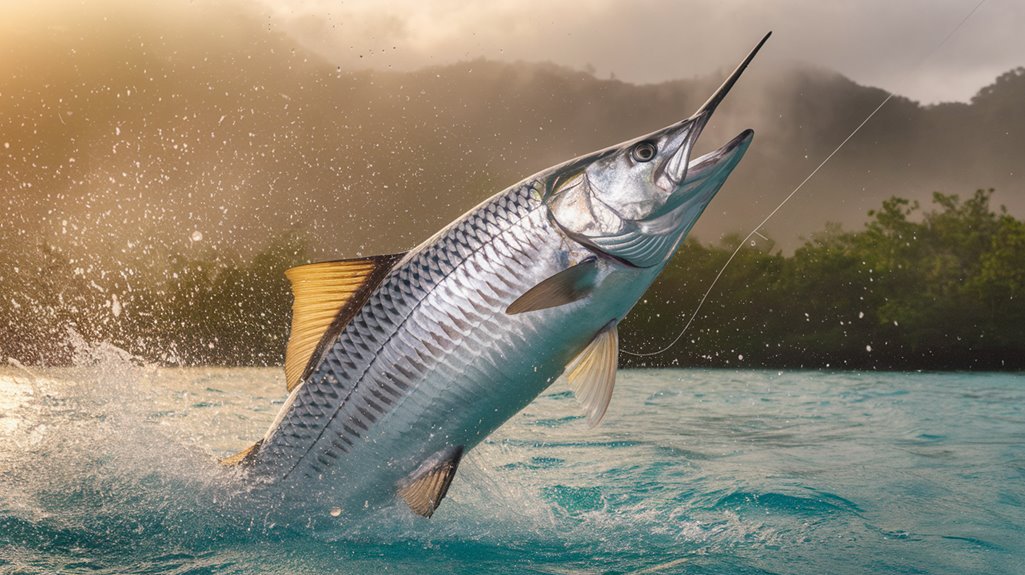You might wonder if Panama's reputation as a world-class tarpon fishery lives up to the hype. From the crystal-clear waters of Bocas del Toro to the historic Panama Canal zone, you'll find these magnificent gamefish patrolling the coastlines year-round. Whether you're casting live sardines at dawn or working poppers during the afternoon bite, Panama's diverse fishing grounds offer opportunities that'll test your skills and potentially reward you with the catch of a lifetime.
- Key Takeaways
- The Ultimate Guide to Panama Tarpon Fishing Locations
- Best Seasons and Times for Landing Your Trophy Tarpon
- Essential Gear and Tackle for Panama Tarpon Success
- Proven Techniques for Catching Panama's Silver Kings
- Top Panama Fishing Lodges and Accommodations
- Local Expert Guides and Charter Services
- Understanding Tarpon Behavior and Habitats
- Weather Patterns and Their Impact on Tarpon Fishing
- Transportation and Logistics for Your Fishing Adventure
- Conservation and Fishing Regulations in Panama
- Additional Species to Target While Tarpon Fishing
- Frequently Asked Questions
- Conclusion
Key Takeaways
- Bocas del Toro archipelago offers premier tarpon fishing, especially near Changuinola and Sixaola river mouths with high catch rates.
- Peak fishing season runs August through April, with best activity from 6-10 am and 3-7 pm daily.
- Use heavy-duty tackle including 30-80 lb rated rods and 50+ lb braided line with fluorocarbon leaders.
- Partner with local guides who know seasonal patterns and prime locations for increased success rates.
- Practice catch and release, obtain proper fishing licenses, and avoid restricted areas during spawning months May-July.
The Ultimate Guide to Panama Tarpon Fishing Locations
Panama's pristine waters offer world-class tarpon fishing opportunities, with the Bocas del Toro archipelago standing out as the premier destination. You'll find the most productive spots near the Changuinola and Sixaola river mouths, where both juvenile and adult tarpon congregate in significant numbers.
When targeting these powerful gamefish, you'll want to focus your efforts during peak hours: early morning from 6 am to 10 am, or late afternoon between 3 pm and 7 pm. The Panama Canal presents an alternative fishing ground, though with lower catch rates than Bocas del Toro. For ideal results, use live bait like sardines near river mouths and in brackish waters. The historic Bayano River on the Pacific side offers a unique tarpon fishing experience, with success rates closely tied to tidal movements.
Best Seasons and Times for Landing Your Trophy Tarpon
You'll find prime tarpon fishing in Panama from August through April, with particularly strong opportunities during the dry season when weather conditions are most favorable for spotting and landing trophy fish. Your best chances for success come during two daily windows: the early morning hours of 6 am to 10 am, and the late afternoon period from 3 pm to 7 pm when tarpon are most active. While juvenile tarpon concentrate near river mouths year-round in Bocas del Toro, you'll want to avoid the May-July spawning season when adult tarpon numbers drop considerably in coastal waters.
Prime Seasonal Fishing Windows
While tarpon can be caught year-round in Panama's waters, the prime trophy season spans from August through April, offering anglers their best shot at landing these magnificent gamefish. You'll find peak activity during early morning hours from 6 am to 10 am and late afternoon from 3 pm to 7 pm when fishing inshore locations along the Caribbean coast. River mouth fishing at spots like Changuinola and Sixaola remains productive throughout the day, as both juvenile and adult tarpon congregate near these nutrient-rich areas. Plan to avoid the May through July spawning period, when tarpon numbers decrease considerably in Bocas del Toro. Success rates fluctuate with monthly changes in weather patterns and baitfish movements, so timing your expedition within the prime season markedly improves your chances.
Daily Timing for Success
Understanding daily timing patterns greatly impacts your tarpon fishing success in Panama's Caribbean waters. You'll find ideal inshore fishing conditions during two prime windows: early morning from 6 am to 10 am, and late afternoon between 3 pm and 7 pm. These periods align with tarpon's natural feeding behaviors, maximizing your chances of a successful catch.
If you're targeting river mouth locations, you'll have more flexibility in your schedule. These areas remain productive throughout the day, offering consistent opportunities regardless of the time. However, you'll need to factor in local weather patterns, as Caribbean conditions can greatly affect fishing outcomes. During the May-July spawning season, you might need to adjust your daily timing strategy as tarpon movements shift toward riverine environments.
Essential Gear and Tackle for Panama Tarpon Success

Successful tarpon fishing in Panama demands three core pieces of equipment: a robust 30-80 lb rated rod, a high-capacity reel with smooth drag, and strong braided line of at least 50 lbs test. You'll need fluorocarbon leaders between 50-80 lbs to resist abrasion from the tarpon's bony mouth while maintaining low visibility.
| Essential Gear | Specifications |
|---|---|
| Rod Length | 7-9 feet |
| Reel Size | 4000-6000 |
| Line Type | 50+ lb Braid |
| Leader | 50-80 lb Fluorocarbon |
| Hook Size | 5/0 – 7/0 |
Your essential tackle should include CD-14 or Yo-Zuri Crystal Minnow lures, plus appropriately sized hooks for live bait fishing. This setup will help you manage the tarpon's powerful initial runs, which can strip 100 meters of line in seconds.
Proven Techniques for Catching Panama's Silver Kings
You'll find Panama's most productive tarpon grounds in Bocas del Toro and the Bayano River, where coordinating your fishing times with ideal tidal movements maximizes your chances for success. Your gear selection must include heavy-duty conventional or spinning tackle capable of handling fish in the 50-160 pound range, paired with circle hooks and wire leaders for live bait presentations. During peak seasons, you'll want to focus on river mouths during dawn and dusk hours, using either live sardines near the surface or weighted jigs in deeper water, depending on where the fish are holding.
Top Spots For Success
While Panama offers numerous prime fishing locations, the Bocas del Toro archipelago stands out as the ultimate destination for landing trophy tarpon. You'll find exceptional opportunities near the Changuinola and Sixaola river mouths, where both juvenile and adult specimens congregate throughout the year. For ideal fishing times, plan your outings between 6 am to 10 am or 3 pm to 7 pm, though river mouth fishing remains productive all day. However, avoid the May-July spawning period when tarpon numbers typically decrease. You'll want to partner with experienced fishing guides who understand local tarpon behavior and can position you effectively. They'll help you deploy live bait like sardines or work jigs in deeper waters near river mouths, greatly increasing your chances of a successful catch.
Essential Gear And Tackle
Proper gear selection makes the difference between landing and losing Panama's mighty tarpon. You'll need a heavy-duty spinning or baitcasting rod rated for 30-80 lb test line, coupled with a high-capacity reel that can withstand explosive runs of up to 100 meters. Essential gear for successful catch-and-release includes 5/0 to 8/0 circle hooks and wire leaders to prevent bite-offs.
- Match your tackle to the challenge: Use robust rods and reels capable of handling tarpon weighing 50-160 pounds
- Select appropriate terminal tackle: Wire leaders and circle hooks are vital for both landing fish and ensuring their safe release
- Choose effective bait options: Live bait like sardines and mullet, or artificial lures such as CD-14s and Yo-Zuri Crystal Minnows will entice these powerful gamefish
Seasonal Fishing Strategies
Understanding Panama's tarpon fishing seasons plays an essential role in planning successful outings. You'll find peak fishing opportunities from August through April, with ideal times during early morning and late afternoon hours. Focus your efforts around river mouths in Bocas del Toro, where both juvenile tarpon and adults congregate.
Adjust your fishing techniques based on seasonal patterns. During May through July's spawning season, migratory tarpon move upriver, requiring you to shift your strategy away from Bocas. Deploy deeper water methods for mature fish, while using lighter tackle when targeting juvenile tarpon in mangroves and flats. Monitor weather conditions and baitfish movements, as these factors directly influence tarpon behavior. When fishing river mouths, live sardines and jigs prove particularly effective during prime fishing season.
Top Panama Fishing Lodges and Accommodations
For anglers seeking the ultimate tarpon fishing experience in Panama, the country's diverse range of quality accommodations delivers strategic access to prime fishing waters. You'll find carefully vetted 3-5 star properties positioned near premier fishing hotspots, including the Bocas del Toro archipelago and Panama Canal region. Your stay is enhanced with tailored recommendations from Central America Fishing Services, matching your specific fishing preferences with ideal lodging choices.
- Luxury business hotels and upscale boutiques for comfort-focused anglers
- Beachfront properties offering direct access to prime tarpon fishing grounds
- Eco-lodges providing an immersive natural experience while staying close to fishing hotspots
You'll benefit from extensive support services, including VIP airport greetings, private English-speaking drivers, and round-the-clock assistance throughout your fishing adventure.
Local Expert Guides and Charter Services

When you're planning your tarpon fishing expedition in Panama, you'll want to connect with the region's expert captains and crews who bring years of local knowledge to your pursuit. Your success rate increases considerably with guides who understand seasonal patterns, prime locations, and proven techniques specific to Panama's waters, particularly in hotspots like Bocas del Toro. These professionals can help you select and book the right charter package that matches your skill level and preferences, whether you're looking for a basic fishing trip or an all-encompassing experience with added amenities like beach lunches and island tours.
Experienced Captains and Crews
Skilled local captains and guides form the backbone of Panama's world-class tarpon fishing experience. You'll benefit from their extensive knowledge of tarpon habitats and seasonal patterns, maximizing your chances of landing these magnificent fish. These experienced local guides provide expert advice tailored to your skill level and preferred fishing methods, whether you're fly fishing or using live bait.
- Access to certified guides with years of experience in Panama's waters, ensuring you'll learn proven techniques
- Thorough charter packages including top-quality equipment, refreshments, and transportation
- In-depth education about responsible fishing practices and local ecological systems
Your captain's expertise extends beyond merely finding fish; they'll share valuable insights about marine conservation and regional regulations while delivering a professional, safety-focused experience that enhances your fishing adventure.
Charter Selection and Booking
Booking the right charter service marks the first step toward a successful Panama tarpon expedition. Charter options start around $700 for half-day inshore trips, accommodating groups of 1-4 anglers. You'll find experienced local guides who understand tarpon habitats and can coach you on proven fishing techniques specific to Panama's waters.
When booking a charter, you'll gain access to professional-grade equipment, quality bait, and tackle, eliminating the need to transport your own gear. Many operators offer customizable experiences beyond fishing, including beach BBQs and snorkel stops. During peak tarpon fishing seasons, demand surges for the most skilled guides, so secure your reservation well in advance. Consider operators who provide extensive packages with food, drinks, and additional activities to maximize your fishing adventure.
Understanding Tarpon Behavior and Habitats
To effectively target tarpon in Panama's waters, you'll need to understand their unique biological adaptations and habitat preferences. These remarkable fish utilize a specialized swim bladder to breathe air, enabling them to thrive in oxygen-poor environments like mangroves and estuaries. Their migratory behavior follows seasonal patterns, with peak activity during spawning from May to July, when they're less prevalent in Bocas del Toro.
- Target brackish environments and river mouths where tarpon hunt for small fish and crustaceans
- Focus on areas with mangrove cover, especially when seeking juvenile specimens
- Adjust your fishing locations based on seasonal movements, particularly during spawning periods
Understanding their feeding habits is vital – they're suction feeders without teeth, so they rely on quick strikes to capture prey in their bony mouths.
Weather Patterns and Their Impact on Tarpon Fishing
Understanding Panama's weather patterns is essential for successful tarpon fishing, particularly along the Caribbean Coast where conditions can change rapidly. You'll find the best fishing success during clear weather, when visibility improves your chances of spotting and catching these powerful game fish.
Time your fishing excursions for early morning or late afternoon when conditions are typically calmer and tarpon are most active. During the May-July spawning season, you'll notice decreased tarpon populations in Bocas del Toro as they migrate upriver. However, the rainy season creates opportunities near river mouths, where increased water flow attracts congregating tarpon. Watch for monthly changes in wind and water temperature, as these factors influence baitfish movements and, consequently, tarpon feeding patterns. Monitoring these weather patterns will greatly improve your chances of a successful catch.
Transportation and Logistics for Your Fishing Adventure
Once you've planned around Panama's weather patterns, getting to your fishing destination requires careful logistical coordination. Your customized vacation begins with VIP airport meet and greet services, where English-speaking drivers guarantee seamless transfers to your accommodations. Local expertise guides the selection of quality hotels, from luxury business properties to eco lodges, positioning you strategically near prime fishing locations.
- 24/7 support team manages transportation logistics throughout your stay
- Personal property visits by local experts assure ideal accommodation selection
- Customized transfer services adapt to your group's specific needs and schedule
Your fishing adventure benefits from thorough planning and verified local connections, eliminating common travel hassles. This all-encompassing approach to transportation and logistics lets you focus on what matters most – the exceptional tarpon fishing that awaits in Panama's waters.
Conservation and Fishing Regulations in Panama
While Panama's waters teem with prized game fish, strict conservation measures protect the sustainability of tarpon and other species. You'll need to observe mandatory catch and release practices for tarpon, roosterfish, and cubera snapper under current fishing regulations. These rules help maintain healthy populations for future generations.
Before heading out, you must obtain a fishing license and familiarize yourself with local guidelines. Plan your expedition between August and April, targeting prime fishing hours from 6-10 am or 3-7 pm for best results. During tarpon spawning months (May-July), you'll find restricted access to certain areas, particularly river mouths. Your guide will provide essential updates on conservation practices and bag limits, ensuring your compliance with Panama's protective measures.
Additional Species to Target While Tarpon Fishing
Panama's rich marine ecosystem offers more than just tarpon fishing opportunities. While pursuing tarpon, you'll encounter diverse species that make each expedition uniquely rewarding. The waters of Panama host an impressive variety of game fish, particularly in the Bocas del Toro region, where both inshore and offshore fishing deliver exceptional results.
- Target Spanish and King mackerel in the inshore waters using live bait or jigs
- Troll offshore for pelagic species like Mahi Mahi, Tuna, and Wahoo
- Explore seasonal opportunities with local charters to maximize species-specific catches
Your fishing strategy can adapt based on weather conditions and time of year, allowing you to switch between targeting tarpon and other species. The region's biodiversity guarantees productive fishing year-round, whether you're casting for juvenile tarpon inshore or pursuing larger game fish offshore.
Frequently Asked Questions
What Month Is Best for Tarpon Fishing?
You'll find peak tarpon action from September through December, with October being your prime month. They're most active during these months due to ideal baitfish patterns and weather conditions.
What Month Is Best to Fish in Panama?
You'd think summer's best, but December through March actually offers Panama's prime fishing. For tarpon specifically, you'll want to hit the Caribbean waters from August through early April.
Where Is the Best Place to Fish for Tarpon?
You'll find the best tarpon fishing in Bocas del Toro archipelago, especially near Changuinola and Sixaola river mouths. These locations consistently produce both juvenile and adult tarpon throughout the season.
Can You Catch Tarpon in Panama City?
You'll find excellent tarpon fishing in Panama City during summer months. They're abundant in local estuaries and coastal waters, where you can target them using bottom fishing or trolling techniques.
Conclusion
You'll discover that Panama's tarpon fishery represents one of sport fishing's finest treasures. By implementing the proven techniques, seasonal timing, and specialized gear outlined above, you've positioned yourself to engage with these magnificent gamefish. Whether you're casting live sardines at river mouths or trolling along mangrove edges, your preparation will maximize success rates. Remember to document catch data and practice catch-and-release to guarantee sustainable fishing for future generations.

